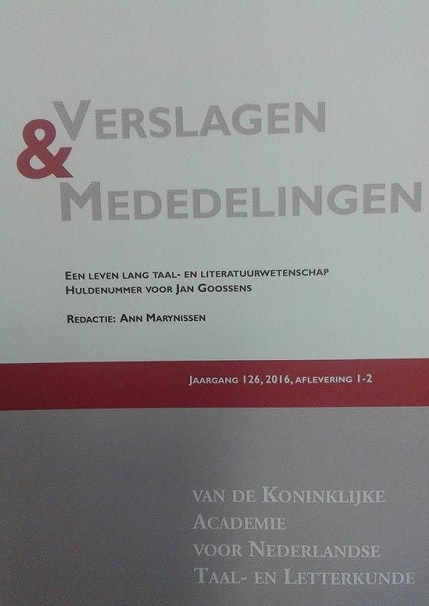Vlaamse heteroniemen voor hooi- en graanstapels
Samenvatting
Het artikel ter ere van professor Jan Goossens handelt over de traditionele benamingen voor hooi- en graanstapels in de Vlaamse dialecten (Frans-, West-, Oost- en Zeeuws-Vlaanderen). Van zeven ‘stapel’-begrippen wordt een woordkaart gepresenteerd en besproken, met aandacht voor geografische patronen, etymologie en benoemingsmotieven, alsook polysemie en heterosemie binnen het behandelde woordveld. Het onderzoek knoopt aan bij Jan Goossens’ studie van oogststapelbenamingen in de dialecten van Belgisch-Limburg, een onderdeel van zijn in 1963 gepubliceerde proefschrift Semantische vraagstukken uit de taal van het landbouwbedrijf in Belgisch-Limburg. Vergelijking tussen het westelijk-perifere Vlaanderen en het
oostelijke Limburg brengt zowel overeenkomsten als verschillen aan het licht. Sommige ‘stapel’-termen, zoals "opper", "hukkel(ing)" en "mijt", worden in beide regio’s aangetroffen en delen bovendien hun dominerende
betekenis: zowel Vlaams als Limburgs "opper" duidt een ronde stapel aan, voornamelijk van hooi, en "hukkel(ing)" wordt hoofdzakelijk gebruikt voor een kleine, ronde hooihoop op het maaiveld. Een ander
punt van overeenkomst is het frequente voorkomen van polysemie (dezelfde benaming duidt op dezelfde opnameplaats twee of meer stapels aan) en heterosemie (dezelfde benaming duidt op verschillende opnameplaatsen een verschillend type stapel aan). Opvallende verschillen zijn o.m. dat de Vlaamse dialecten gekenmerkt worden door een grotere meernamigheid dan de Limburgse, dat de Limburgse kaartbeelden homogener en overzichtelijker zijn, en dat alleen in Limburg duidelijke voorbeelden geattesteerd zijn van woordverlies uit homonymievrees.
This article in honour of professor Jan Goossens deals with the traditional designations for harvest stacks in the Flemish dialects (French-, West-, East- and Zealand-Flanders). Seven onomasiological maps are presented, showing the heteronymy of the small stack of newly mown hay raked together on the field (2.2.1), the medium stack (not generally practiced) on the field (2.2.2), the tall stack made on the field shortly before the harvest is taken in (2.2.3), the permanent hay stack in the neighbourhood of the farm (2.2.4), the small round corn stack on the field (2.3.1), the two types of corn stacks near the farm in which the sheaves remain until being threshed, the one being of conical shape (2.3.2) and the other of square shape (2.3.3). The investigation is in line with Jan Goossens’ onomasiologic and semasiologic exploration of the same conceptual field in the dialects of the Belgian province of Limburg (Goossens 1963). A comparison between the Flemish and the Limburg dialects brings to light similarities as well as differences. Both dialect groups have a number of ‘hay stack’ terms in common, such as "opper", "hukkel(ing)" and "mijt", and the dominant meaning of each of those shared terms is highly similar in both regions. As to the differences, the Flemish vocabulary in the conceptual field of harvest stacks shows generally more lexical variation than the Limburg dialects. Furthermore the Limburg lexical maps show more sharply delimited lexical areas than their Flemish counterparts. Finally, only the Limburg dialects offer clear examples of word loss due to homonymophobia.
- Auteurs behouden de auteursrechten en geven het tijdschrift het recht van eerste publicatie van het werk onder een Creative Commons Attribution Licentie die anderen het recht geeft het werk te delen onder vermelding van het auteurschap van het werk en de eerste publicatie in dit tijdschrift.
- Auteurs mogen separate, additionele contractuele overeenkomsten aangaan voor het niet-exclusief distribueren van de door het tijdschrift gepubliceerde versie van het werk (bv. plaatsing in een institutionele repository of publicatie in een boek), onder vermelding van de eerste publicatie in dit tijdschrift.
- Auteurs hebben het recht en worden aangemoedigd om hun werk online beschikbaar te stellen (bv. in institutionele repositories of op hun website) voorafgaand aan en gedurende de inzending, aangezien dat kan leiden tot productieve discussies, sneller en meer citaties van het gepubliceerde werk (Zie The Effect of Open Access).


